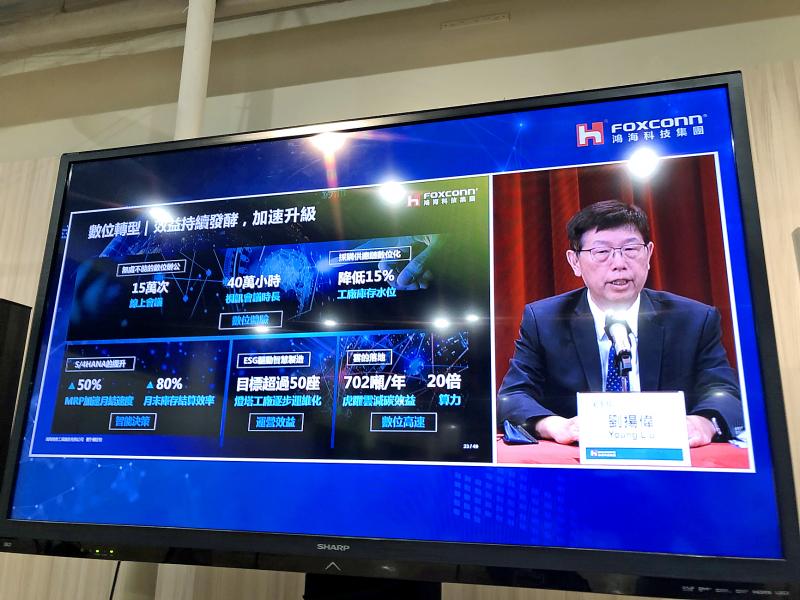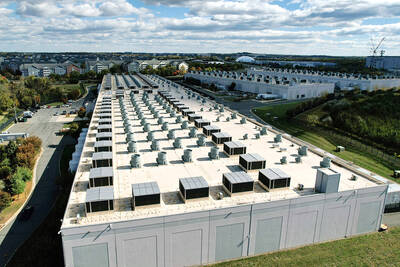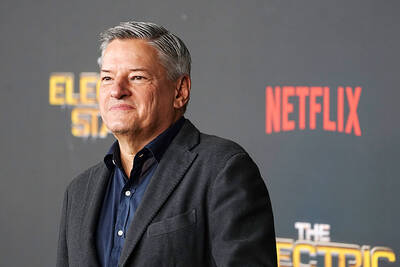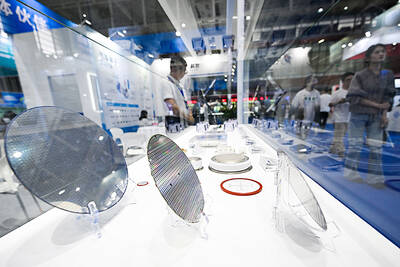Hon Hai Precision Industry Co (鴻海精密) is exploring new business opportunities in technologies related to low Earth orbit (LEO) and smart car connectivity, the company said yesterday.
Hon Hai chairman Young Liu (劉揚偉) last week said that an LEO satellite from Hon Hai might be seen in the sky next year, as the company aims to create more value and higher returns for its shareholders, while the firm told yesterday’s forum that Microelectronics Technology Inc (台揚科技), a 5G equipment and satellite component supplier that it fully owns via its subsidiaries, has tapped into the LEO satellite receiver market.
At the NExT Forum, organized by the Hon Hai Research Institute (鴻海研究院), industry experts discussed the development of 5G and 6G (B5G) technologies, as well as opportunities that lie beyond, focusing on LEO supply chains and their link to the fulfillment of autonomous vehicles.

Photo: CNA
Numerous applications rely on having full coverage of B5G, LEO and low-latency networks with high-reliability design, research institute chairman Wu Jen-ming (吳仁銘) said.
National Space Organization Director-General Wu Jong-shine (吳宗信) said that a large-scale company such as Hon Hai should tap into space travel and space colonies, adding that such businesses would drive growth over the next 20 to 30 years.
To meet growing demand for full Internet coverage, especially in rural areas, existing 5G networks can be integrated with 6G technology or LEO satellite technology, Wu said.
There are four LEO satellite projects globally: SpaceX’s Starlink, the UK and India’s Oneweb, Amazon.com Inc’s Project Kuiper and Canada’s Telesat, he said.
By the end of the year, Starlink is to take the lead with 3,400 satellites launched, he said.
Some local networking companies and precision machinery companies have joined Starlink’s supply chain, supplying ground equipment for satellites, he added.
Wu said he is upbeat about business opportunities related to LEO satellites, as there are expected to be 50,000 satellites in the sky by 2030, with 77.5 percent of them being LEO satellites.
The ground equipment segment in 2020 comprised a significant portion of the global space economy, contributing US$135.3 billion, data compiled by Bryce Space and Technology and Euroconsult showed.
The global space economy is expected to expand to US$1 trillion by 2040 from US$371 billion in 2020, Wu said.
The satellite industry accounted for 74 percent of the global space economy in 2020, he said, citing data from Bryce Space and Technology and Euroconsult.
The research institute, which was established in January last year, directs the exploration of next-generation telecommunications and semiconductor technologies. It has focused on 5G-related technologies, satellite payload technologies and the ability to deploy satellite receiving stations.

The demise of the coal industry left the US’ Appalachian region in tatters, with lost jobs, spoiled water and countless kilometers of abandoned underground mines. Now entrepreneurs are eyeing the rural region with ambitious visions to rebuild its economy by converting old mines into solar power systems and data centers that could help fuel the increasing power demands of the artificial intelligence (AI) boom. One such project is underway by a non-profit team calling itself Energy DELTA (Discovery, Education, Learning and Technology Accelerator) Lab, which is looking to develop energy sources on about 26,305 hectares of old coal land in

Taiwan’s exports soared 56 percent year-on-year to an all-time high of US$64.05 billion last month, propelled by surging global demand for artificial intelligence (AI), high-performance computing and cloud service infrastructure, the Ministry of Finance said yesterday. Department of Statistics Director-General Beatrice Tsai (蔡美娜) called the figure an unexpected upside surprise, citing a wave of technology orders from overseas customers alongside the usual year-end shopping season for technology products. Growth is likely to remain strong this month, she said, projecting a 40 percent to 45 percent expansion on an annual basis. The outperformance could prompt the Directorate-General of Budget, Accounting and

Netflix on Friday faced fierce criticism over its blockbuster deal to acquire Warner Bros Discovery. The streaming giant is already viewed as a pariah in some Hollywood circles, largely due to its reluctance to release content in theaters and its disruption of traditional industry practices. As Netflix emerged as the likely winning bidder for Warner Bros — the studio behind Casablanca, the Harry Potter movies and Friends — Hollywood’s elite launched an aggressive campaign against the acquisition. Titanic director James Cameron called the buyout a “disaster,” while a group of prominent producers are lobbying US Congress to oppose the deal,

Two Chinese chipmakers are attracting strong retail investor demand, buoyed by industry peer Moore Threads Technology Co’s (摩爾線程) stellar debut. The retail portion of MetaX Integrated Circuits (Shanghai) Co’s (上海沐曦) upcoming initial public offering (IPO) was 2,986 times oversubscribed on Friday, according to a filing. Meanwhile, Beijing Onmicro Electronics Co (北京昂瑞微), which makes radio frequency chips, was 2,899 times oversubscribed on Friday, its filing showed. The bids coincided with Moore Threads’ trading debut, which surged 425 percent on Friday after raising 8 billion yuan (US$1.13 billion) on bets that the company could emerge as a viable local competitor to Nvidia